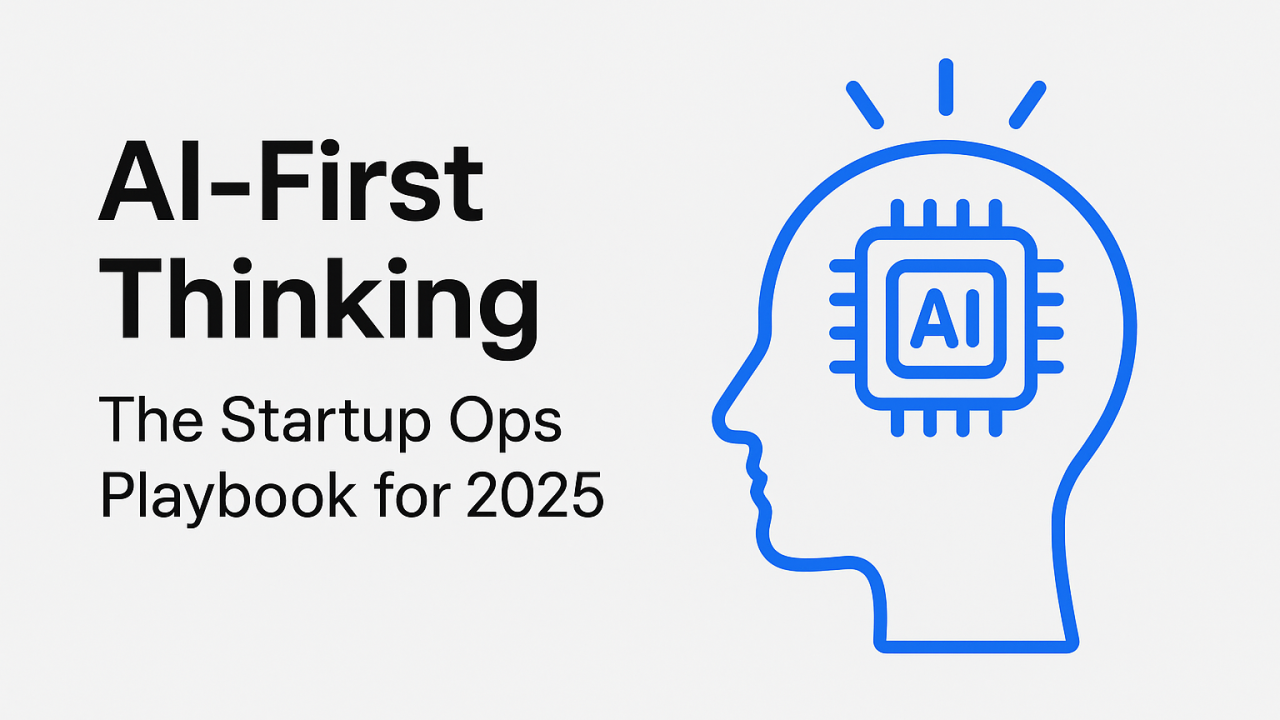AI-First Thinking: The Startup Ops Playbook for 2025
In 2025, the battlefield for startup survival isn’t just about having a brilliant idea or securing Series A funding. It’s about operational velocity. A recent Gartner study predicts that by next year, over 50% of enterprise-level applications will have embedded AI. For startups, this isn’t just a trend; it’s an existential threat if ignored. The old playbook of “hire more people, throw more software at the problem” is a direct path to burning cash and losing ground. This is where a fundamental mindset shift becomes critical: adopting AI-first thinking for startups.
This isn’t another article hyping up the latest generative AI tool. This is a strategic guide for founders, CTOs, and entrepreneurs who understand that to win, you must build your operations on a foundation of intelligence from day one. We’ll explore how to move from merely using AI tools to architecting your entire operational framework around AI’s capabilities. By the end, you’ll have a clear blueprint for transforming your startup’s efficiency, scalability, and competitive edge.
The Ticking Clock: Why Legacy Startup Operations Are Obsolete
For decades, the startup mantra was “move fast and break things.” This often translated into chaotic, manual processes held together by spreadsheets, Slack messages, and sheer human effort. But in today’s hyper-competitive landscape, this model is fundamentally broken.
The primary pain points are scalability and efficiency.
- Resource Constraints: Every hire is a significant financial commitment. Manually handling customer support, lead qualification, or data analysis means your growth is directly and expensively tied to headcount.
- The Data Deluge: Startups today collect more data than ever, but most of it sits dormant in databases. Without the ability to analyze and act on it in real-time, valuable insights are lost, leading to poor decision-making. As per a Forrester report, data-driven organizations are 162% more likely to significantly surpass revenue goals.
- Competitive Pressure: Well-funded incumbents and agile, AI-native competitors are automating their way to lower customer acquisition costs (CAC) and higher lifetime value (LTV). Competing with them using a manual-first approach is like bringing a horse to a Formula 1 race.
The old way isn’t just inefficient; it’s a liability that actively prevents you from scaling.
Beyond the Buzzwords: What is AI-First Thinking, Really?
Let’s be clear: AI-first thinking is not about simply buying a subscription to a few AI tools. It’s a strategic philosophy.
AI-first thinking is the practice of designing your products, processes, and culture by asking, “How can artificial intelligence solve this problem from the start?” instead of “Can we bolt an AI tool onto our existing process?”
Here’s the difference:

An AI-first startup views intelligence not as an add-on, but as a core utility, like electricity or the internet. This fundamental shift impacts every aspect of startup operations transformation, from product development to human resources.
The AI Transformation Blueprint: Your 5-Step Implementation Guide
Transitioning to an AI-first model requires a structured approach. It’s a marathon, not a sprint. Here is a practical, step-by-step framework to guide your journey.
Step 1: Architect a Foundational Data Strategy
AI is fueled by data. Without a clean, accessible, and well-governed data pipeline, any AI initiative will fail.
- Centralize Your Data: Break down silos. Consolidate customer, product, and operational data into a single source of truth, like a cloud data warehouse (e.g., BigQuery, Snowflake).
- Prioritize Data Quality: Implement automated data validation and cleaning processes. Garbage in, garbage out.
- Ensure Accessibility: Use tools and platforms that make it easy for both technical and non-technical teams to access and query data securely.
Step 2: Identify High-Impact Operational Bottlenecks
Don’t try to boil the ocean. Start by applying AI in startup operations where it will deliver the most significant ROI. Map out your core processes and identify the biggest time sinks and resource drains.
- Customer Support: Repetitive queries, ticket categorization, and initial troubleshooting.
- Sales & Marketing: Lead scoring, content creation, email personalization, and market research.
- Engineering: Code generation, bug detection, and automated testing in CI/CD pipelines.
- Finance & HR: Invoice processing, expense reporting, and candidate screening.
Step 3: Embed, Don’t Just Integrate, AI
Select your first project. Choose a process where success is easily measurable. For example, reducing customer support response time.
- Pilot a Solution: Start with an off-the-shelf tool or a managed AI service from a cloud provider to get a quick win.
- Measure Everything: Track key metrics before and after implementation. Did the AI reduce costs? Improve speed? Increase customer satisfaction?
- Iterate and Expand: Use the learnings from your pilot to refine the solution and identify the next bottleneck to tackle.
Step 4: Automate Back-Office Functions Ruthlessly
The back office is ripe for AI automation startups thrive on. These functions are often cost centers, and every hour saved is an hour that can be reallocated to growth-driving activities. Use AI-powered tools to automate tasks like bookkeeping, contract analysis, and employee onboarding.
Step 5: Cultivate an AI-Literate Culture
Technology is only half the battle. Your team is the other half.
- Invest in Training: Provide resources for your team to understand the basics of AI and how it applies to their roles.
- Promote Experimentation: Create a culture where it’s safe to experiment with new AI tools and processes, even if they sometimes fail.
- Lead from the Top: As a founder or leader, you must champion the AI-first vision and communicate its importance consistently.
Overwhelmed by the options? Building an AI-first operation requires a solid plan. Schedule a call, to understand “AI Implementation Checklist for Startups” and to ensure you cover all your bases, from data strategy to tool selection.
Expert Insights: Best Practices for an AI-First Strategy
Implementing AI is a journey filled with potential. To navigate it successfully, keep these expert tips in mind.
- Start with the “Why,” Not the “What”: Don’t get distracted by the latest shiny AI tool. Start with a clear business problem you need to solve. A clear ROI will secure buy-in and maintain momentum.
- Embrace Human-in-the-Loop (HITL): AI is a powerful assistant, not a replacement for human judgment. For critical tasks, design workflows where AI provides recommendations, but a human makes the final decision. This mitigates risk and builds trust.
- Prioritize Ethical AI and Governance: Be transparent with your customers about how you use AI and their data. Comply with regulations like GDPR and CCPA. Biased algorithms can destroy your brand’s reputation; build fairness checks into your models from the start.
- Think Platform, Not Point Solutions: While individual tools are useful, a long-term AI strategy is built on a flexible platform (like AWS, Google Cloud, or Azure). This allows you to build custom solutions and scale your AI capabilities as your needs evolve. This is where partners like CloudBloq provide immense value in architecting the right foundation.
The Modern Startup Stack: Essential AI Tools for 2025
Building an AI-first operation doesn’t have to mean building everything from scratch. The market is filled with powerful tools that embed generative AI for business.
Here’s a look at the essential categories

Common Pitfalls: Mistakes to Avoid on Your AI Journey
The path to AI transformation is littered with failed projects. Avoid these common mistakes:
- The “Magic Wand” Fallacy: Believing AI can solve a poorly defined problem or fix a broken process. AI amplifies; it doesn’t magically create order from chaos. Fix the process first.
- Ignoring Data Privacy: Misusing customer data for AI training without consent is a legal and ethical minefield. Be rigorous about data governance.
- Underestimating Change Management: Deploying a new AI tool without training your team or explaining its benefits will lead to low adoption and wasted investment.
- Chasing Hype: Investing in a complex deep learning project when a simple regression model or an off-the-shelf API would suffice. Focus on the simplest solution that solves the problem.
The Future is Autonomous: Startup Ops in 2026 and Beyond
The current wave of AI is just the beginning. The trend is moving towards hyper-automation, where entire chains of complex business processes are run autonomously with minimal human intervention.
We will see the rise of the AI-native company—businesses whose core product or service is not just enhanced by AI, but is impossible to deliver without it. For startups, this means the opportunities will be immense, but the table stakes will be higher. Having an AI-first operational model won’t just be a competitive advantage; it will be a prerequisite for survival.
Conclusion: Your Next Move in the AI Revolution
Adopting AI-first thinking for startups is the single most impactful strategic shift you can make in 2025. It’s about fundamentally re-architecting your company to be leaner, faster, and more intelligent than your competition. By doing so, you move from a model of linear growth (tied to headcount) to one of exponential growth (tied to data and intelligence).
Key Takeaways:
- Mindset Over Tools: AI-first is a strategic philosophy that must permeate your company culture, not just your tech stack.
- Data is the Foundation: A clean, accessible data strategy is non-negotiable for any successful AI implementation.
- Start Small, Scale Smart: Focus on high-impact bottlenecks first to prove ROI and build momentum for your AI initiatives.
- Automate to Elevate: Use AI to automate repetitive tasks, freeing your human talent to focus on high-value, creative, and strategic work.
The tools and technology are here. The question is no longer if AI will transform your business, but how quickly you can adapt to lead the charge.
Ready to build your AI-first foundation? The experts at CloudBloq can help you design and implement a scalable cloud infrastructure optimized for your AI workloads.
Schedule a free consultation today Let’s Connect
Frequently Asked Questions (FAQ)
1. How can a bootstrapped startup afford to implement AI? Start lean. You don’t need a team of data scientists. Begin with affordable, API-based AI services from cloud providers or leverage the built-in AI features of software you already use (like your CRM or email marketing tool). Focus on automating one small, high-cost process to generate immediate savings that can fund further investment.
2. What is the very first step to becoming an AI-first company? The first step is a data audit. You can’t do anything with AI without understanding what data you have, where it lives, and its quality. Identify your most valuable data sources and create a plan to centralize and clean them. This is the foundational slab upon which everything else is built.
3. Will AI replace jobs at my startup? AI is more likely to transform jobs than eliminate them. It automates tedious, repetitive tasks, allowing your team to focus on more strategic responsibilities. An AI-first approach enables your customer support agent to become a customer success manager, and your marketer to become a growth strategist. It’s about augmentation, not replacement.
4. How do I measure the ROI of AI in my operations? Define clear KPIs before you start. For a customer service bot, this could be a reduction in average response time or cost-per-ticket. For a sales AI, it might be an increase in lead conversion rate. Tie every AI project to a tangible business metric like revenue growth, cost savings, or customer satisfaction.
5. What’s the difference between Machine Learning and AI-first thinking? Machine Learning (ML) is a technology—a subset of AI where systems learn from data. AI-first thinking is a strategy. It’s the business philosophy of using technologies like ML to design your entire operational model from the ground up for maximum efficiency and intelligence.
6. Do I need to hire a data scientist to get started? Not necessarily. For many initial use cases, modern low-code/no-code AI platforms and SaaS tools with embedded AI are sufficient. You can achieve significant results by hiring or training employees to be “AI champions” who are skilled at using these tools, rather than building models from scratch.
7. How can AI help with product development itself? AI is revolutionizing the software development lifecycle (SDLC). Tools like GitHub Copilot accelerate coding, AI-powered testing can identify bugs faster, and AI can analyze user feedback at scale to prioritize features for your product roadmap. This speeds up your time-to-market significantly.





